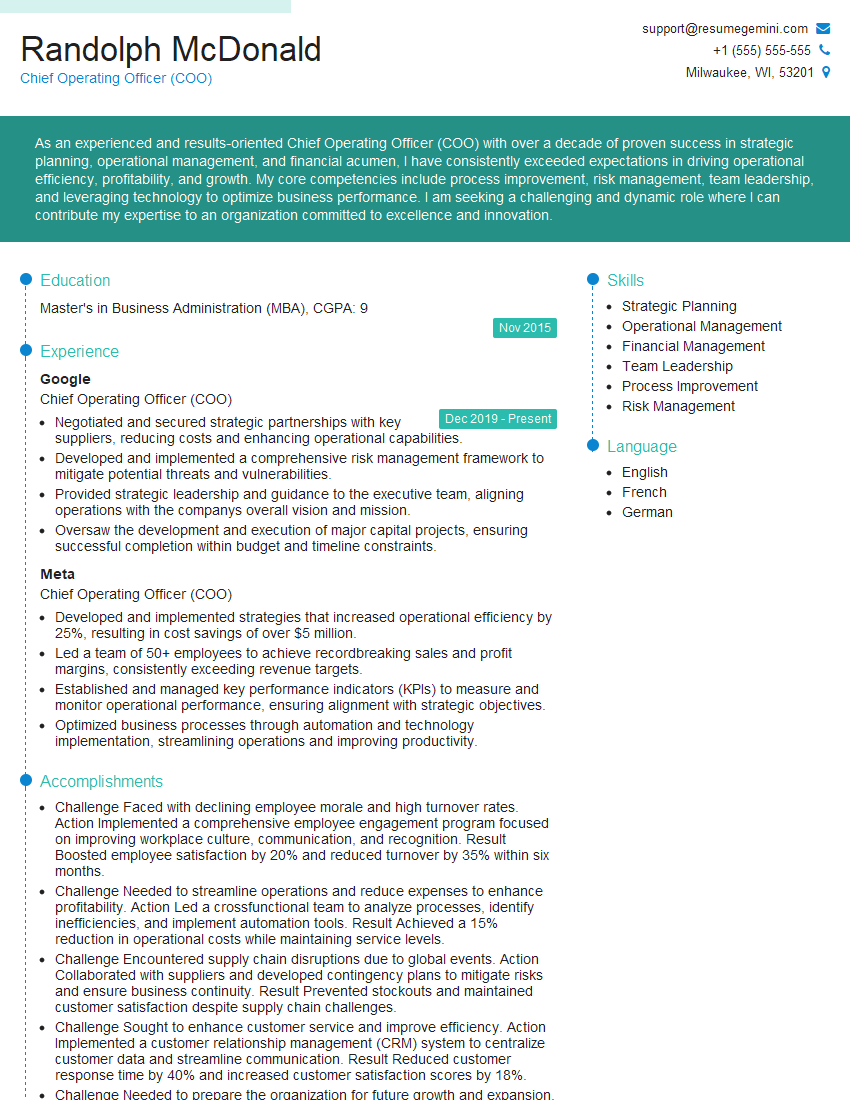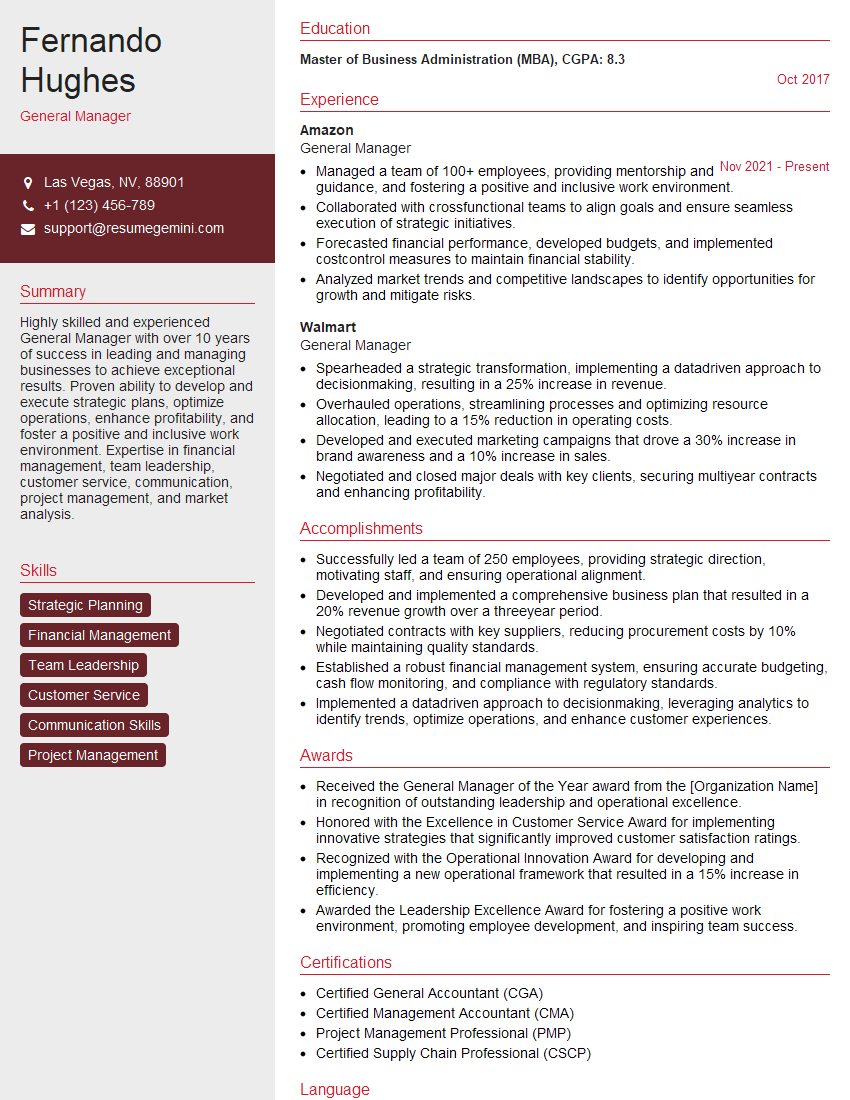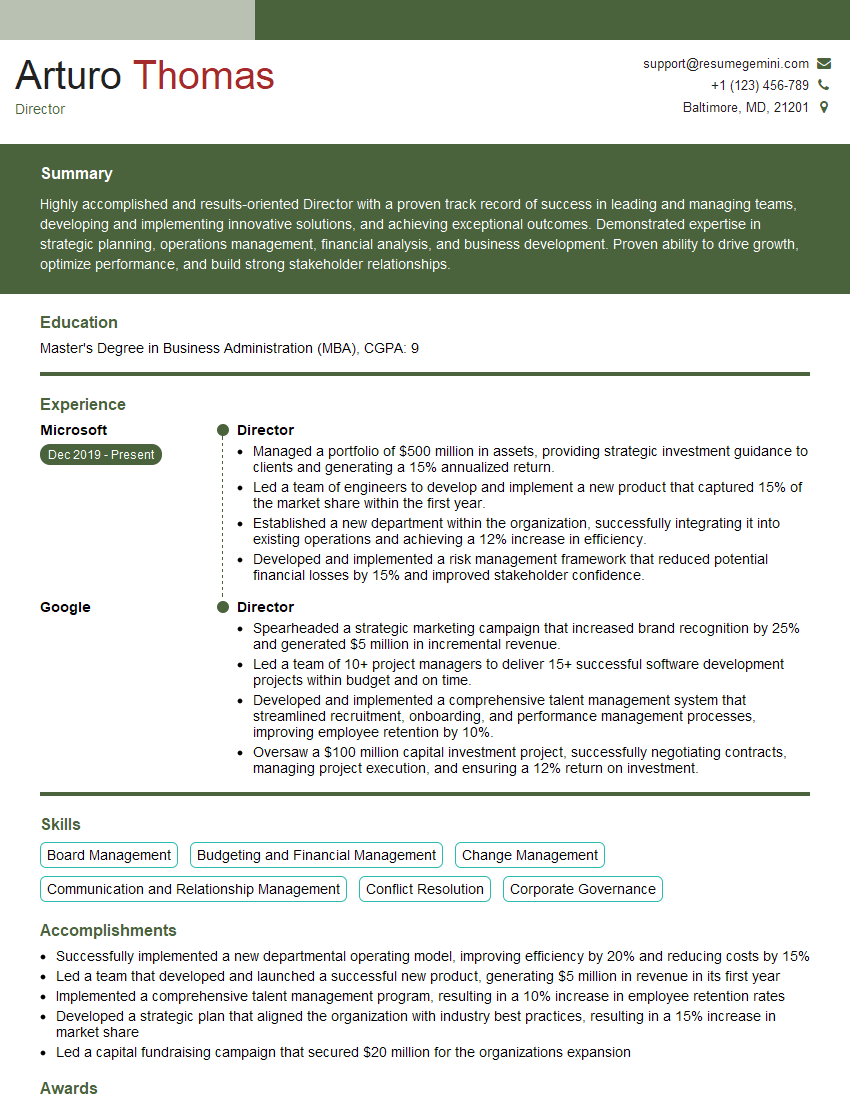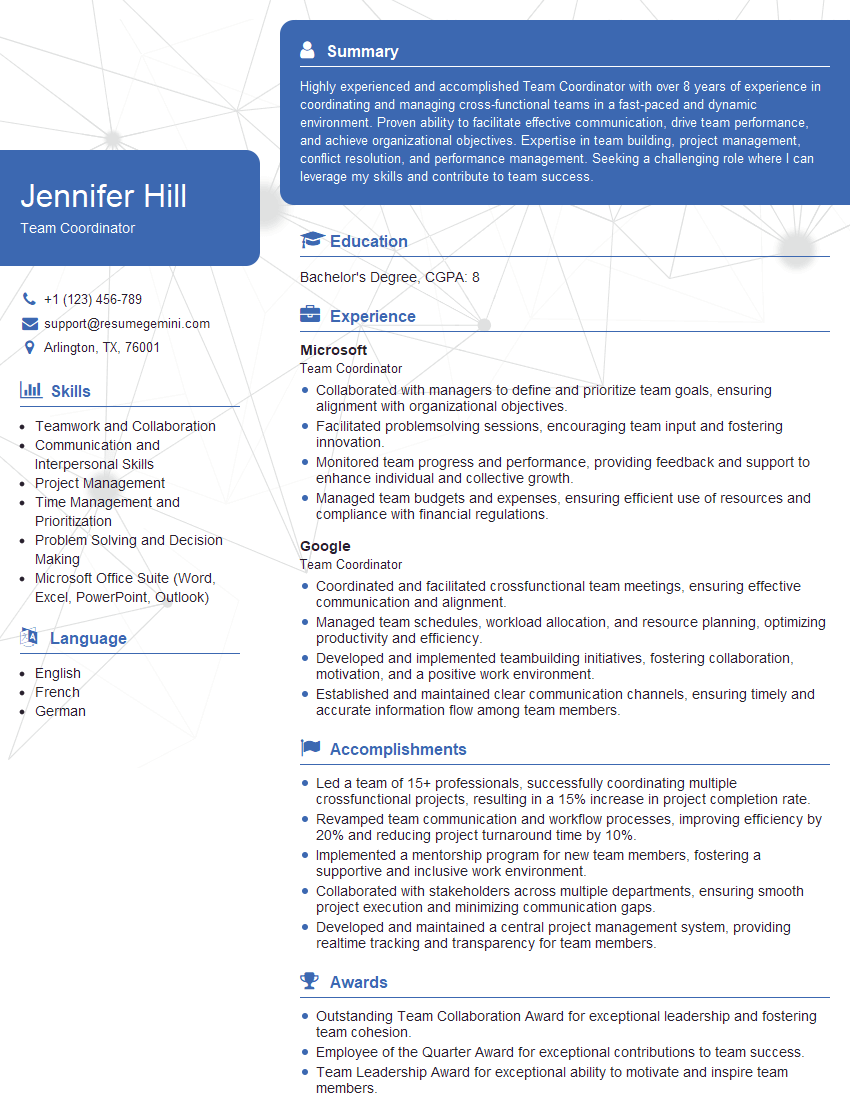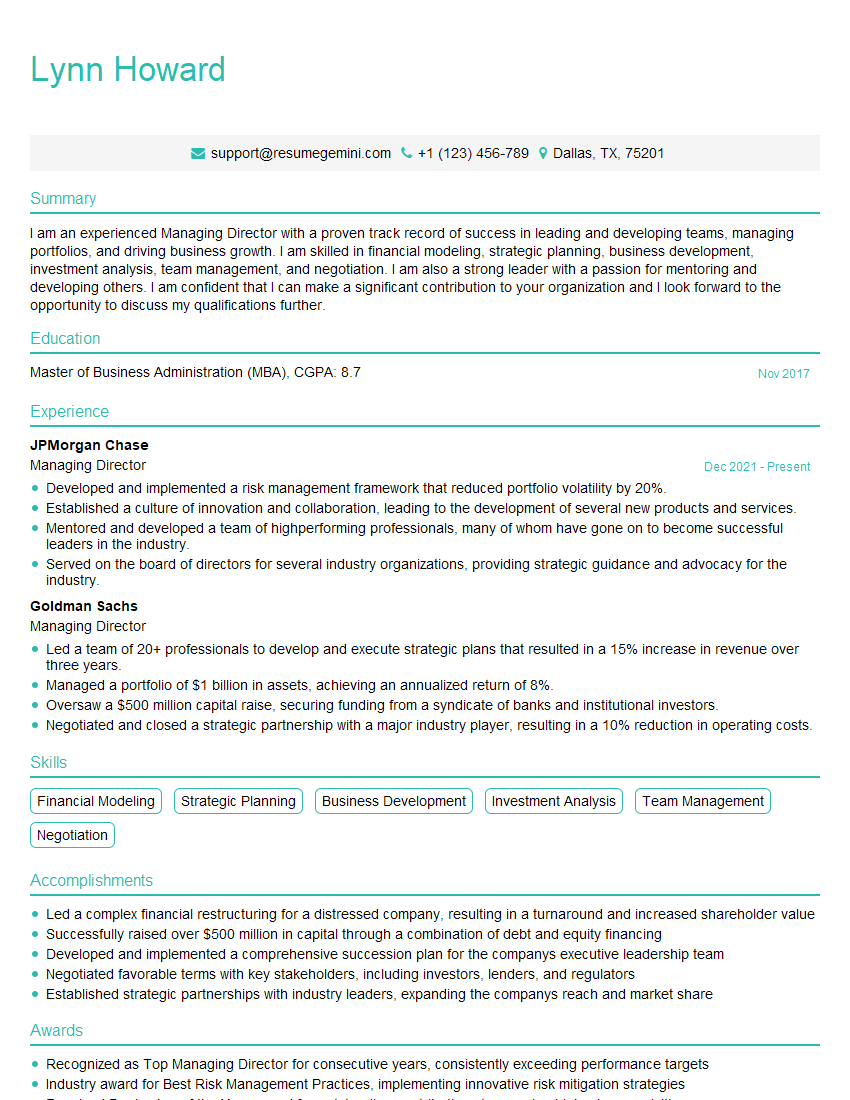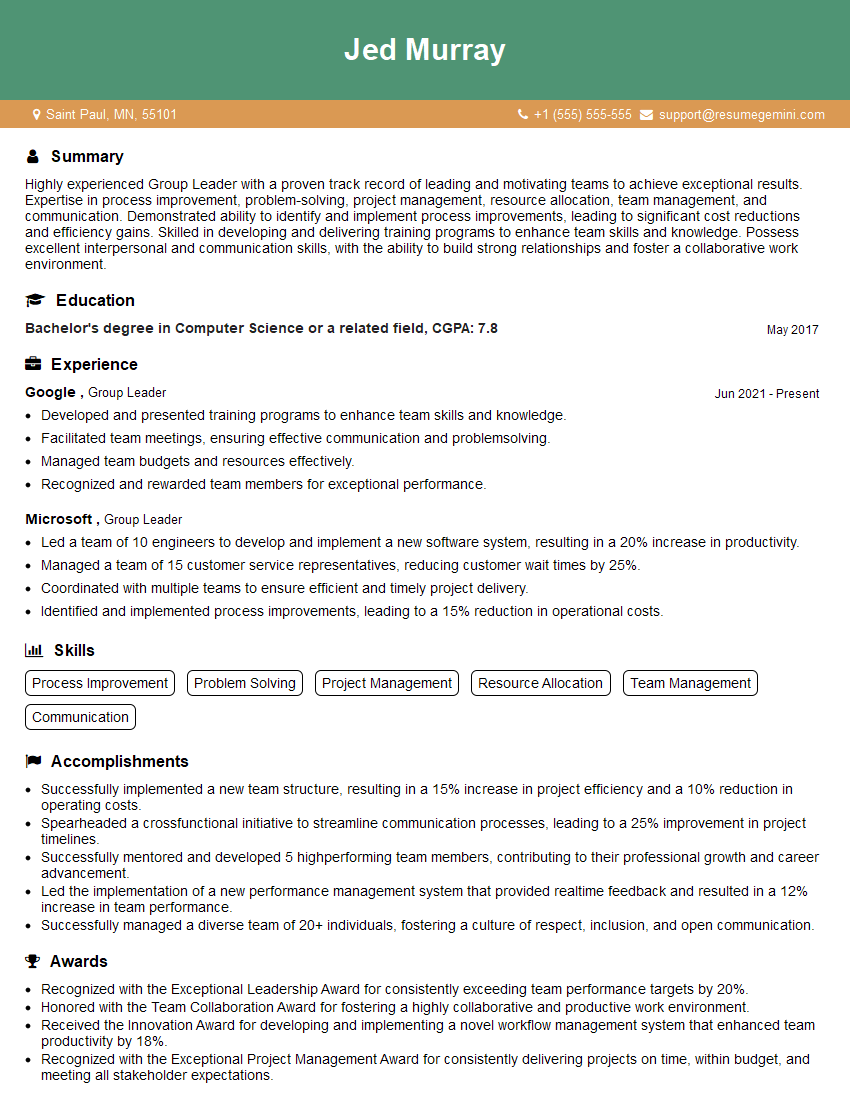Interviews are more than just a Q&A session—they’re a chance to prove your worth. This blog dives into essential Team Leadership and Communication interview questions and expert tips to help you align your answers with what hiring managers are looking for. Start preparing to shine!
Questions Asked in Team Leadership and Communication Interview
Q 1. Describe your approach to building a high-performing team.
Building a high-performing team is a multifaceted process that involves carefully selecting individuals, fostering a collaborative environment, and establishing clear goals and expectations. It’s like assembling a finely tuned orchestra – each musician (team member) needs to be skilled, understand their role, and work in harmony with the others to create beautiful music (achieve team objectives).
Careful Selection: I start by defining the specific skills and personality traits needed for each role. This ensures the right people are in the right places, maximizing individual strengths and minimizing potential conflicts. I rely on thorough interviews and assessments to identify candidates who are not only competent but also collaborative and adaptable.
Clear Goals & Expectations: Once the team is assembled, I ensure everyone understands the team’s overall goals and their individual contributions to those goals. This clarity reduces ambiguity and promotes focused effort. We use SMART goals (Specific, Measurable, Achievable, Relevant, Time-bound) to ensure everyone is on the same page.
Fostering Collaboration: A strong team culture is crucial. I encourage open communication, regular team meetings, and opportunities for team members to interact socially. Building trust and rapport is paramount. Activities like team-building exercises and social events can significantly contribute to this.
Empowerment and Recognition: I empower team members by giving them autonomy and responsibility. I provide the necessary resources and support but trust them to manage their tasks effectively. Recognizing and rewarding good work is also essential to maintain motivation and morale.
Continuous Improvement: I regularly conduct performance reviews, solicit feedback, and encourage continuous learning and development. Adapting to changing circumstances and embracing new ideas are key to maintaining a high-performing team.
Q 2. How do you handle conflict within a team?
Conflict is inevitable in any team, but how it’s handled determines its impact. My approach focuses on addressing the conflict constructively, focusing on the issue, not the personalities. It’s like firefighting – you need to quickly identify the source of the fire (the conflict) and address it before it spreads (escalates).
Identify the Root Cause: The first step is to understand the source of the conflict. I facilitate open and honest conversations, encouraging each party to express their perspective without interruption. Active listening is key here.
Facilitate a Solution-Oriented Discussion: Once the problem is understood, I guide the team towards finding a mutually acceptable solution. This involves brainstorming, compromising, and exploring different options. My role is to mediate, not to dictate.
Document Agreements: Once a solution is reached, it’s crucial to document it clearly. This ensures everyone is aware of their responsibilities and reduces the chances of the conflict recurring. This documentation can be a simple email or a meeting minutes summary.
Follow Up: I follow up to ensure the agreed-upon solution is implemented and to check if any further issues arise. This proactive approach prevents minor conflicts from escalating into major problems.
Q 3. Explain your experience with delegating tasks effectively.
Effective delegation is about entrusting tasks to the right people, ensuring they have the necessary resources, and providing support without micromanaging. It’s about empowering your team to grow their capabilities, freeing you up to focus on more strategic tasks.
Assess Team Member Skills: Before delegating, I assess each team member’s strengths and weaknesses to ensure the task is assigned to someone with the necessary skills and experience. I might use skills matrices or simply rely on my understanding of their individual capabilities.
Provide Clear Instructions and Expectations: I provide clear, concise instructions, outlining the desired outcome, deadlines, and any relevant resources. I ensure the task is well-defined, avoiding ambiguity.
Offer Support and Guidance: I provide regular check-ins to monitor progress and offer support without micromanaging. I am available to answer questions and provide guidance when needed. This shows trust and empowers the team member.
Regular Feedback and Recognition: I provide regular feedback on performance, offering both constructive criticism and praise. Recognizing their contributions reinforces positive behavior and encourages future successful delegation.
Q 4. How do you provide constructive feedback to team members?
Constructive feedback is about helping team members improve their performance and develop their skills. It’s not about criticism for criticism’s sake but about providing specific, actionable advice that will lead to growth. It’s like a GPS – it guides the person to their destination (improved performance) by giving specific directions, not just saying ‘go there’.
Focus on Specific Behaviors: I avoid generalizations and instead focus on specific behaviors or actions. For example, instead of saying ‘you’re disorganized,’ I might say, ‘I noticed your reports were late this week. Let’s discuss how we can improve your time management.’
Balance Positive and Negative Feedback: I start by highlighting positive aspects of their work before addressing areas for improvement. This creates a more receptive environment and avoids making the feedback feel overly negative.
Offer Solutions and Suggestions: I don’t just point out problems; I also offer solutions and suggestions for improvement. This shows that I am invested in their success and provides a clear path forward.
Use a Two-Way Conversation: I encourage a two-way conversation where the team member can ask questions and clarify concerns. This ensures the feedback is understood and promotes a sense of partnership.
Q 5. How do you motivate and inspire your team?
Motivating and inspiring a team requires understanding individual needs and creating an environment where everyone feels valued and empowered. It’s not a one-size-fits-all approach; it’s like gardening – you need to nurture each plant (team member) according to its specific needs to help it thrive.
Recognize and Reward Achievements: Publicly acknowledging and rewarding team accomplishments boosts morale and reinforces positive behavior. This can be through formal awards, informal recognition, or simply a heartfelt ‘thank you’.
Provide Opportunities for Growth: Offering training, mentorship, or challenging assignments helps team members develop their skills and advance their careers. This demonstrates investment in their future and fuels motivation.
Foster a Positive and Supportive Environment: Creating a positive and supportive work environment where people feel respected and valued is essential. This involves promoting open communication, collaboration, and mutual respect.
Lead by Example: Demonstrating passion, commitment, and hard work inspires team members to do the same. Actions speak louder than words.
Empowerment and Autonomy: Giving team members autonomy and control over their work empowers them and increases their sense of ownership and responsibility.
Q 6. Describe a time you had to make a difficult decision impacting your team.
In a previous role, we faced a significant budget cut that required reducing our team size. This was a difficult decision because it meant letting go of valued team members. My approach involved several steps to ensure fairness and transparency.
Data-Driven Approach: I gathered data on individual performance, skills, and contributions to the team. This ensured the selection process was based on objective criteria, not personal preferences.
Open and Honest Communication: I communicated the need for downsizing openly and honestly with the team. I explained the reasons behind the decision and answered their questions as openly as possible.
Fair and Transparent Selection Process: I established a clear and transparent selection process to determine which roles would be eliminated. This process was carefully considered and documented to avoid any perception of unfairness.
Support for Affected Employees: I provided outplacement services and support to the affected team members, including help with their job search and resume writing. I also ensured they received the respect and appreciation they deserved.
Maintaining Team Morale: I focused on maintaining the morale of the remaining team members by emphasizing the importance of their contributions and expressing confidence in their abilities.
Q 7. How do you measure team success?
Measuring team success is crucial for identifying areas of strength and areas needing improvement. It’s not just about meeting deadlines; it’s about achieving the overall goals and objectives set for the team, while also considering the well-being and growth of the team members. Think of it like assessing the health of an organism – you need to look at various vital signs to determine its overall health.
Quantitative Metrics: These involve measurable data like project completion rates, sales figures, customer satisfaction scores, and efficiency metrics. These offer concrete evidence of team performance.
Qualitative Metrics: These focus on less tangible aspects such as team collaboration, communication effectiveness, employee satisfaction, and innovation. They are often gathered through surveys, feedback sessions, and observations.
Goal Achievement: The primary measure of success is whether the team has achieved its pre-defined goals and objectives. This requires regular progress monitoring and adjustments as needed.
Individual Growth: Measuring individual growth and development is also important. Have team members improved their skills? Have they taken on new challenges? These factors contribute to a high-performing team.
Continuous Improvement: Regularly reviewing performance data and gathering feedback allows for continuous improvement and adaptation. This iterative approach ensures the team stays on track and meets its goals.
Q 8. How do you foster collaboration and teamwork?
Fostering collaboration and teamwork is about creating an environment where individuals feel valued, respected, and empowered to contribute their best. It’s not just about assigning tasks; it’s about building relationships and a shared sense of purpose.
- Clearly Defined Roles and Responsibilities: Each team member should understand their role and how it contributes to the overall goal. Ambiguity leads to conflict and inefficiency. For example, in a software development team, clearly defining roles like frontend developer, backend developer, and project manager prevents overlaps and ensures everyone knows their area of focus.
- Open and Honest Communication: Regular team meetings, both formal and informal, are crucial. These sessions provide opportunities for updates, brainstorming, and problem-solving. I encourage active listening and constructive feedback to ensure everyone feels heard.
- Shared Goals and Vision: Teams work best when they understand the ‘why’ behind their work. Clearly articulating the project goals and the team’s contribution to the bigger picture inspires commitment and shared responsibility. For instance, in a marketing campaign, sharing the overall business objective and how the team’s activities will contribute to achieving it enhances their motivation.
- Team-Building Activities: Informal activities, like team lunches or off-site events, help build camaraderie and trust. This fosters a more relaxed and collaborative atmosphere, encouraging members to interact outside of project-related tasks.
- Recognition and Appreciation: Acknowledging individual and team accomplishments boosts morale and motivates continued collaboration. Publicly celebrating successes, no matter how small, reinforces positive behaviors and strengthens the team bond.
Q 9. How do you manage a team with diverse skill sets and personalities?
Managing a diverse team requires understanding that different personalities and skill sets bring unique strengths and perspectives. The key is to leverage these differences to create a synergistic and productive environment.
- Individualized Approach: Recognize that each team member has different working styles, communication preferences, and learning speeds. I tailor my approach to each individual, providing the support and guidance they need to thrive. This might involve providing more frequent check-ins for some, and allowing others more autonomy.
- Clear Communication Strategies: Establish clear communication channels and protocols to ensure everyone stays informed and can easily access information. This may include using project management software, regular team meetings, and individual check-ins.
- Conflict Resolution: Disagreements are inevitable in diverse teams. I proactively address conflicts by fostering open dialogue, encouraging active listening, and seeking win-win solutions. Mediation might be necessary in some cases to ensure fair and productive outcomes.
- Leveraging Strengths: I focus on assigning tasks based on individual strengths and interests. This allows team members to utilize their skills effectively, contributing to higher quality work and increased job satisfaction. This also facilitates cross-training and knowledge sharing across team members.
- Respect for Diversity: Creating a culture of inclusivity and respect is crucial. Team members should feel comfortable expressing their opinions and sharing their perspectives, regardless of background or personality. I actively promote a safe and welcoming environment for all team members.
Q 10. How do you handle underperforming team members?
Addressing underperformance requires a careful and empathetic approach. It’s crucial to understand the root cause of the issue before implementing any solution.
- Identify the Problem: Schedule a private meeting with the underperforming team member. Use open-ended questions to understand their perspective and identify any obstacles they’re facing. This could be lack of training, unclear expectations, personal issues, or a lack of motivation.
- Set Clear Expectations: Clearly define performance expectations and metrics. Ensure the team member understands what constitutes successful performance and the consequences of continued underperformance.
- Provide Support and Resources: Offer support and resources to help the team member improve their performance. This might include additional training, mentoring, or assistance with task management.
- Create a Performance Improvement Plan (PIP): If the underperformance persists, a formal PIP with specific, measurable, achievable, relevant, and time-bound (SMART) goals is developed. Regular check-ins are scheduled to track progress and provide support.
- Consequences: If the team member fails to meet the goals of the PIP, despite receiving support, further action such as disciplinary measures may be necessary. This process should always be handled fairly and in line with company policies.
Q 11. How do you prioritize tasks and manage deadlines within a team?
Prioritizing tasks and managing deadlines effectively requires a structured approach and open communication within the team.
- Prioritization Framework: Employ a prioritization framework like the Eisenhower Matrix (urgent/important), MoSCoW method (must have/should have/could have/won’t have), or value vs. effort matrix. This helps to objectively assess task importance and urgency.
- Project Management Tools: Utilize project management tools like Trello, Asana, or Jira to track progress, assign tasks, and manage deadlines. These tools offer visibility into project status and help ensure accountability.
- Regular Team Meetings: Conduct regular stand-up meetings to discuss progress, identify roadblocks, and re-prioritize tasks as needed. This promotes transparency and allows for collaborative problem-solving.
- Timeboxing: Allocate specific time blocks for working on different tasks to improve focus and prevent task-switching. This enhances productivity and aids in meeting deadlines.
- Contingency Planning: Build buffer time into the schedule to account for unexpected delays or unforeseen circumstances. This proactive approach helps to mitigate risks and maintain project timelines.
Q 12. Describe your experience with remote team management.
My experience with remote team management has highlighted the importance of proactive communication, trust, and leveraging technology effectively. It’s about building relationships even when physical proximity is limited.
- Regular Virtual Meetings: Frequent video conferencing, not just email or chat, maintains personal connection and ensures clear communication. I use a variety of meeting formats like project updates, brainstorming sessions, and informal virtual coffee breaks.
- Asynchronous Communication: I understand that team members may be in different time zones, so I encourage asynchronous communication using project management tools and shared documents. This flexibility accommodates individual schedules and time preferences.
- Building Trust and Rapport: Taking the time to build personal relationships with remote team members is crucial, even if it’s through virtual interactions. Showing empathy and understanding, particularly during challenging times, strengthens team cohesion.
- Technology and Tools: Mastering the use of collaboration tools like Slack, Microsoft Teams, or Zoom is essential for efficient communication and project management. I provide training and support to my team members to help them navigate these tools effectively.
- Clear Expectations and Goals: Remote teams need extremely clear expectations and documented processes to avoid confusion and ensure everyone is on the same page. This includes well-defined roles, responsibilities, and performance metrics.
Q 13. How do you ensure effective communication within a large team?
Ensuring effective communication in large teams requires a multi-pronged strategy that combines different communication channels and fosters a culture of open dialogue.
- Centralized Communication Hub: Utilize a centralized communication platform (like Slack or Microsoft Teams) for announcements, updates, and general team discussions. This prevents information silos and ensures everyone is informed.
- Targeted Communication: Use specific communication channels for different purposes. For example, email for formal announcements, instant messaging for quick questions, and project management software for task updates.
- Regular Team Meetings: Organize regular team meetings to discuss progress, address concerns, and facilitate collaboration. These meetings should be structured and well-organized to maximize efficiency.
- Cross-Functional Communication: Foster communication and collaboration between different teams or departments to prevent information bottlenecks and improve overall workflow.
- Feedback Mechanisms: Establish mechanisms for team members to provide feedback and raise concerns. This can be through surveys, feedback sessions, or anonymous suggestion boxes. Active listening and responsiveness to feedback build trust and improve communication.
Q 14. Explain your approach to resolving communication breakdowns.
My approach to resolving communication breakdowns involves identifying the root cause, facilitating open dialogue, and implementing preventative measures.
- Identify the Breakdown: Pinpoint the specific communication issue. Is it a lack of clarity, misinterpretation, conflicting information, or a breakdown in communication channels?
- Facilitate Open Dialogue: Bring the involved parties together in a safe and neutral environment. Encourage open and honest communication, focusing on understanding each perspective rather than assigning blame.
- Active Listening: Practice active listening to ensure everyone feels heard and understood. This involves paraphrasing, summarizing, and asking clarifying questions.
- Collaborative Problem-Solving: Work collaboratively to find a solution that addresses the root cause of the breakdown. This might involve clarifying roles, improving communication channels, or implementing new processes.
- Preventative Measures: Implement measures to prevent similar breakdowns in the future. This might involve establishing clearer communication protocols, providing additional training, or improving team cohesion. A post-incident review helps to learn from mistakes and make improvements.
Q 15. How do you adapt your communication style to different audiences?
Adapting communication style is crucial for effective leadership. It’s about understanding your audience and tailoring your message to resonate with their background, experience, and preferred communication style. I assess my audience based on several factors: their seniority, technical expertise, personality, and cultural background.
- For senior management: I use concise, data-driven communication, focusing on strategic impact and high-level summaries. I might use presentations with key performance indicators (KPIs) and concise bullet points.
- For technical teams: I favor detailed, precise explanations, employing technical terminology where appropriate. I might use diagrams and flowcharts to illustrate complex processes.
- For less experienced team members: I opt for a more patient, supportive, and detailed approach, ensuring clear instructions and providing opportunities for questions and clarification. I would use simpler language and more visual aids.
- For diverse cultural backgrounds: I’m mindful of potential cultural nuances in communication styles, such as direct versus indirect communication, and adapt accordingly. I make sure to actively listen and observe for non-verbal cues.
Essentially, it’s about finding the right balance between clarity, conciseness, and engagement for each specific audience. The goal is always to ensure the message is understood and acted upon.
Career Expert Tips:
- Ace those interviews! Prepare effectively by reviewing the Top 50 Most Common Interview Questions on ResumeGemini.
- Navigate your job search with confidence! Explore a wide range of Career Tips on ResumeGemini. Learn about common challenges and recommendations to overcome them.
- Craft the perfect resume! Master the Art of Resume Writing with ResumeGemini’s guide. Showcase your unique qualifications and achievements effectively.
- Don’t miss out on holiday savings! Build your dream resume with ResumeGemini’s ATS optimized templates.
Q 16. How do you utilize technology to enhance team communication?
Technology plays a vital role in enhancing team communication. I utilize various tools to facilitate seamless collaboration and information sharing.
- Project Management Software (e.g., Asana, Jira): Centralizes task management, progress tracking, and communication threads, improving transparency and accountability.
- Instant Messaging (e.g., Slack, Microsoft Teams): Enables quick, informal communication, facilitating rapid problem-solving and efficient collaboration. We use channels for different projects and purposes to keep things organized.
- Video Conferencing (e.g., Zoom, Google Meet): Enables face-to-face interactions, crucial for building relationships and fostering a sense of community, particularly in remote teams.
- Document Collaboration Tools (e.g., Google Docs, Microsoft Office 365): Allows multiple team members to work on documents simultaneously, reducing version control issues and promoting shared understanding.
However, I believe it’s crucial to use technology thoughtfully. Over-reliance on technology can hinder personal connections. I make a conscious effort to balance digital communication with in-person interactions whenever possible to foster a strong team spirit.
Q 17. Describe a time you had to communicate bad news to your team.
In a previous role, we faced budget cuts that resulted in a team restructure. I had to communicate the news of impending layoffs to my team. I approached this with empathy and transparency.
- Prior Preparation: I met with senior management to thoroughly understand the situation and the rationale behind the decisions.
- Planned Communication: I scheduled a meeting specifically to address the layoffs. I ensured everyone was informed simultaneously to prevent rumors and maintain fairness.
- Empathetic Delivery: I acknowledged the difficulty of the situation, expressing my understanding of their concerns and anxieties. I spoke directly, honestly, and with respect, emphasizing the rationale behind the difficult decision.
- Support and Resources: I outlined the support systems available to affected employees, including outplacement services and career counseling. I also emphasized the team’s continued commitment to those remaining.
While the news was undeniably upsetting, the open and honest communication helped the team navigate the transition with greater understanding and resilience. It fostered trust and maintained a sense of unity within the remaining team.
Q 18. How do you facilitate effective meetings?
Effective meetings require careful planning and facilitation. I adhere to the following principles:
- Clear Purpose and Agenda: I always start by defining the meeting’s objective and distributing a clear agenda beforehand. This ensures everyone is prepared and understands the expected outcome.
- Time Management: I stick to the allocated time, ensuring discussions stay focused. I assign time slots for each agenda item to maintain pace and prevent tangents.
- Active Participation: I encourage active participation from all team members, creating a safe space for open discussion and diverse perspectives. I use techniques like brainstorming and round-robin discussions to involve everyone.
- Actionable Outcomes: I conclude each meeting by summarizing key decisions, assigning action items with clear deadlines, and outlining next steps. I document these outcomes and distribute them to all participants.
- Post-Meeting Follow-up: I send a brief summary email reiterating key decisions and action items to ensure everyone is on the same page.
By following these steps, I ensure that meetings are productive, efficient, and contribute meaningfully to the team’s goals. Avoid lengthy meetings without a clear objective; they are a waste of everyone’s time.
Q 19. How do you handle difficult conversations with team members?
Handling difficult conversations requires tact, empathy, and a structured approach. My strategy involves:
- Private and Respectful Setting: I always choose a private and comfortable setting to ensure the team member feels safe and respected.
- Active Listening: I begin by actively listening to their perspective without interruption, demonstrating empathy and understanding.
- Clear and Concise Communication: I state my concerns clearly and concisely, using “I” statements to avoid blaming or accusatory language.
- Collaborative Problem-Solving: I work collaboratively with the team member to identify the root cause of the issue and develop solutions together. This fosters a sense of ownership and commitment to positive change.
- Documenting Agreements: I document the agreed-upon actions and timelines to ensure accountability and follow-up.
The goal is to resolve the issue constructively, fostering a stronger working relationship and improving performance. It’s important to remember that the focus is on improving the situation, not assigning blame.
Q 20. How do you ensure team members feel valued and respected?
Making team members feel valued and respected is fundamental to building a high-performing team. I achieve this through several strategies:
- Regular Recognition and Appreciation: I actively acknowledge and appreciate individual and team accomplishments, both big and small. This can be through verbal praise, written thank-you notes, or public acknowledgment during team meetings.
- Opportunities for Growth and Development: I provide opportunities for professional development through training, mentorship, and challenging assignments. This demonstrates a commitment to their career progression and growth.
- Open and Honest Communication: I maintain open and honest communication channels, ensuring that team members feel heard and valued. I encourage feedback and create a safe space for expressing concerns.
- Delegation and Empowerment: I delegate tasks and responsibilities that align with their skills and interests, empowering them to take ownership and feel a sense of accomplishment.
- Inclusion and Diversity: I foster a culture of inclusion and diversity, ensuring that every team member feels respected and valued for their unique contributions.
When individuals feel valued, their engagement, motivation, and productivity increase significantly. It’s about creating an environment where everyone feels like they belong and that their work matters.
Q 21. How do you build trust and rapport within your team?
Building trust and rapport is crucial for effective teamwork. I approach this by focusing on:
- Transparency and Honesty: I maintain open and honest communication, sharing information transparently and providing context for decisions. This builds credibility and trust.
- Vulnerability and Authenticity: I demonstrate vulnerability by sharing my own experiences and challenges, fostering a culture of psychological safety.
- Active Listening and Empathy: I actively listen to my team members’ concerns and perspectives, showing empathy and understanding. This helps build strong relationships based on mutual respect.
- Shared Goals and Values: I work collaboratively to define shared team goals and values, ensuring that everyone is aligned and working towards a common purpose.
- Team-Building Activities: I organize team-building activities and social events to foster informal connections and strengthen relationships. This can be anything from casual lunches to more structured team-building exercises.
Trust is earned, not given. By consistently demonstrating integrity, empathy, and commitment, I can build a strong foundation of trust and rapport within my team. It’s an ongoing process, not a one-time event.
Q 22. Describe your experience with mentoring or coaching team members.
Mentoring and coaching are integral to my leadership style. I believe in fostering a culture of continuous growth and development within my teams. My approach is highly individualized, focusing on understanding each team member’s unique strengths, weaknesses, aspirations, and learning styles.
For example, I recently mentored a junior team member who was struggling with public speaking. Instead of simply telling them to practice, I worked with them to identify their anxieties, develop a tailored presentation plan, and provided constructive feedback during practice sessions. We also incorporated role-playing to build their confidence. The result was a significant improvement in their presentation skills and a noticeable boost in their self-assurance. In other instances, I’ve used a more directive coaching style, guiding team members through complex projects by offering strategic advice and breaking down challenging tasks into manageable steps. This tailored approach ensures that every team member receives the support they need to excel.
Q 23. How do you identify and develop leadership potential within your team?
Identifying leadership potential is an ongoing process that involves keen observation and strategic development. I look for individuals who demonstrate initiative, problem-solving skills, a collaborative spirit, and a commitment to continuous improvement. Beyond technical skills, I assess their emotional intelligence, their ability to influence others, and their capacity for empathy.
- Delegation and Observation: I strategically delegate increasingly complex tasks to observe how they handle responsibility and challenges.
- Feedback and Mentorship: I provide regular feedback, focusing on both achievements and areas for growth, offering personalized mentorship to nurture their skills.
- Opportunities for Growth: I actively create opportunities for them to lead small projects, participate in cross-functional teams, and take on leadership roles in training or mentorship programs.
For instance, I identified a team member with strong analytical skills and a proactive approach. I assigned her a lead role in a crucial data analysis project, providing support and guidance throughout. This opportunity allowed her to develop her leadership capabilities, leading to improved team performance and her significant professional growth.
Q 24. How do you manage expectations with stakeholders and team members?
Managing expectations is crucial for maintaining a productive and harmonious team environment. My approach involves clear, consistent, and transparent communication with both stakeholders and team members. This involves setting realistic goals, establishing clear deadlines, and regularly updating everyone on progress.
- Regular Check-ins: I schedule regular check-ins with both stakeholders and team members to discuss progress, address any concerns, and proactively adjust plans as needed.
- Utilizing Project Management Tools: I leverage project management tools (e.g., Jira, Asana) to provide real-time visibility into project progress and resource allocation.
- Documenting Agreements: Important agreements and expectations are always documented to avoid misunderstandings and provide a reference point for everyone involved.
For example, when facing a tight deadline, I might hold a meeting with both stakeholders and the team to collaboratively identify potential bottlenecks and proactively adjust timelines or resource allocation. This collaborative approach helps manage expectations and keeps everyone informed and engaged.
Q 25. How do you ensure your team has the resources it needs to succeed?
Ensuring my team has the necessary resources is paramount to their success. This goes beyond just providing the right tools and technology. It involves understanding their needs and proactively advocating for them.
- Needs Assessment: I regularly assess the team’s needs by conducting surveys, holding brainstorming sessions, and engaging in one-on-one conversations.
- Resource Acquisition: I actively seek out and secure the necessary resources, which might involve budget allocation, training programs, or access to specialized software or equipment.
- Mentorship and Skill Development: I focus on developing my team’s skills through training and mentoring opportunities, empowering them to handle increasingly challenging tasks.
In one instance, my team needed specialized software to automate a repetitive task. I presented a well-justified proposal to management, highlighting the potential cost savings and efficiency gains. The proposal was approved, and the software significantly improved the team’s productivity and morale.
Q 26. How do you stay updated on industry best practices for team leadership?
Staying updated on industry best practices is a continuous process. I actively engage in several strategies to ensure I’m at the forefront of effective team leadership.
- Professional Development: I dedicate time to attending conferences, workshops, and webinars related to team leadership, communication, and project management.
- Industry Publications: I regularly read industry publications, journals, and blogs to stay informed on emerging trends and best practices.
- Networking: I actively engage with other leaders through professional networking groups and online communities, exchanging ideas and experiences.
For example, recently I attended a workshop on ‘Agile Leadership,’ which significantly enhanced my understanding of how to effectively lead teams in dynamic and rapidly changing environments. I immediately incorporated some of these practices into my team’s workflow, resulting in improved efficiency and collaboration.
Q 27. Describe your experience with change management within a team.
Change management is a critical skill for any team leader. My approach involves clear communication, stakeholder engagement, and a phased implementation strategy.
- Communication: I ensure transparency throughout the change process, clearly communicating the reasons for the change, the expected impact, and the timeline for implementation.
- Stakeholder Engagement: I actively involve stakeholders in the planning and implementation stages, addressing their concerns and incorporating their feedback.
- Phased Implementation: I advocate for a phased implementation approach, rolling out changes gradually to minimize disruption and allow for adjustments based on feedback.
In a recent scenario, my team needed to transition to a new project management system. I held several meetings to explain the benefits of the new system, addressed team concerns about the learning curve, and provided comprehensive training. The phased implementation allowed us to identify and address any issues early on, minimizing disruptions and ensuring a smoother transition.
Q 28. How do you maintain work-life balance while managing a team?
Maintaining work-life balance while managing a team requires conscious effort and proactive strategies. It’s not about working less, but about working smarter and more efficiently.
- Prioritization: I prioritize tasks based on urgency and importance, focusing on high-impact activities. I delegate effectively and empower my team members to take ownership of their work.
- Time Blocking: I use time blocking to schedule specific times for focused work, meetings, and personal time. This helps ensure that personal activities are not consistently pushed aside.
- Delegation & Empowerment: I effectively delegate tasks to team members, fostering their growth and freeing up my time for strategic initiatives. This also builds trust and ownership within the team.
- Setting Boundaries: I set clear boundaries between work and personal time, avoiding checking emails or responding to messages outside of designated work hours.
For example, I make it a point to leave work at a reasonable hour and disconnect from work emails and notifications during evenings and weekends. This allows me to recharge and return to work refreshed and focused. This self-care also helps me lead more effectively.
Key Topics to Learn for Team Leadership and Communication Interview
- Understanding Team Dynamics: Explore different team structures, communication styles within teams, and the impact of individual personalities on group performance. Consider the stages of team development and how to navigate conflicts constructively.
- Effective Communication Strategies: Learn practical techniques for active listening, providing constructive feedback, and delivering clear and concise instructions. Practice adapting your communication style to different audiences and situations. Consider the use of both verbal and non-verbal communication.
- Motivation and Delegation: Understand different motivational theories and how to apply them in a team setting. Master the art of delegating tasks effectively, ensuring accountability and fostering a sense of ownership among team members.
- Conflict Resolution and Negotiation: Develop skills in identifying and addressing conflicts proactively. Learn effective negotiation strategies to reach mutually beneficial solutions and maintain positive team relationships.
- Performance Management and Feedback: Understand best practices for setting clear expectations, providing regular feedback, conducting performance reviews, and recognizing individual contributions to team success. Learn how to address underperformance constructively.
- Leading Through Change: Explore strategies for managing change within a team, fostering adaptability, and building resilience during periods of transition or uncertainty.
- Building Trust and Rapport: Understand the importance of building strong relationships within the team, fostering open communication and a culture of trust and mutual respect.
Next Steps
Mastering Team Leadership and Communication is crucial for career advancement. These skills are highly sought after, opening doors to more challenging and rewarding roles with increased responsibility and higher earning potential. To significantly improve your job prospects, it’s vital to create an ATS-friendly resume that highlights your accomplishments and showcases your capabilities effectively. ResumeGemini is a trusted resource to help you build a professional resume that stands out. Use ResumeGemini to craft a compelling narrative that demonstrates your proficiency in Team Leadership and Communication. Examples of resumes tailored to these skills are available within ResumeGemini to guide your creation process.
Explore more articles
Users Rating of Our Blogs
Share Your Experience
We value your feedback! Please rate our content and share your thoughts (optional).
What Readers Say About Our Blog
Hi, I’m Jay, we have a few potential clients that are interested in your services, thought you might be a good fit. I’d love to talk about the details, when do you have time to talk?
Best,
Jay
Founder | CEO
